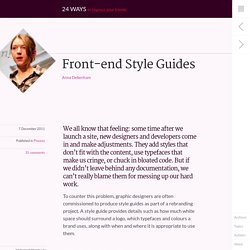

Front-end Style Guides. We all know that feeling: some time after we launch a site, new designers and developers come in and make adjustments.

They add styles that don’t fit with the content, use typefaces that make us cringe, or chuck in bloated code. But if we didn’t leave behind any documentation, we can’t really blame them for messing up our hard work. To counter this problem, graphic designers are often commissioned to produce style guides as part of a rebranding project. A style guide provides details such as how much white space should surround a logo, which typefaces and colours a brand uses, along with when and where it is appropriate to use them.
Design guidelines Some design guidelines focus on visual branding and identity. Some guidelines go further, encompassing a whole experience, from the visual branding to the messaging, and the icon sets used. The BBC’s Global Experience Language. Code standards documents We can make a similar argument for code. The front-end developer’s style guide Easier to test. 6 Most Programmer Friendly CSS Frameworks. There is nothing better than programming in today’s society of WordPress, Joomla and Drupal powered websites, considering most of the scripting is easy to manipulate and many developers can finish projects in bulk – whereas before writing thousands of HTML code took forever.

Programmers who utilize the below six cascading style sheet frameworks will enjoy both quick page loading times, smaller file sizes to work with, extensible plugin support and implementation along with unique printable grid sheets which can be used to draw out designs before actually slapping them live. 960 Grid Systems 960 Grid System is one of the most systematic approaches towards web development which is now followed and appreciated by a significant number of web developers around the world. Web developers can maintain a seamless workflow and correlate different elements of the webpages of any website through this system in an easier way than before. Blueprint CSS Inuit CSS Framework JQuery UI CSS Framework. Bootstrap. Frameworks for Designers. These days, “framework” is quite a buzzword in web development.

With JavaScript frameworks like the Yahoo User Interface library, jQuery, and Prototype getting a lot of attention and web application frameworks like Rails and Django getting even more, it seems like everyone is using some kind of framework to build their sites. But what exactly is a framework? And are they only useful to programmers, or can we web designers benefit from the concept, as well? What is a framework?
#section1 So that we’re all on the same page, let’s agree—at least for the duration of this article—on this definition of “framework”: a set of tools, libraries, conventions, and best practices that attempt to abstract routine tasks into generic modules that can be reused. To be clear, we’re not necessarily talking about something that is built, packaged, and released to the public. A framework for designers#section2 Chances are, you can benefit from a similar abstraction of CSS code for your web design process.
The Articulate Web Designer of Tomorrow. You could say that we design to communicate, and that we seek emotive responses.

It sounds straightforward, and it can be, but leaving it to chance isn’t wise. Many wander into web design without formal training, and whilst that certainly isn’t essential, we owe it to ourselves to draw on wider influences, learn from the past, and think smarter. What knowledge can we ourselves explore in order to become better designers? In addition, how can we take this knowledge, investigate it through our unique discipline, and in turn speak more eloquently about what we do on the web? Below, I outline a number of things that I personally believe all designers should be using and exploring collectively. Taking stock Where we’re at is good. As designers we use ideas, concepts, text and images.
Embracing an established visual language This is a language whose alphabet is shapes, structures, colours, lines and rhythms. Figure 1: Structures (clockwise from top-left): Informal; Formal; Active; Visible.